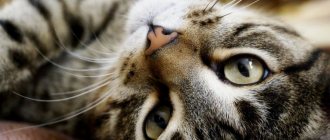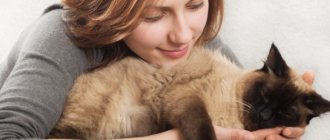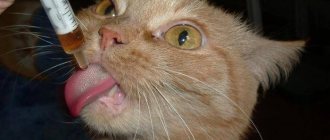Is anesthesia harmful?
There are many myths surrounding veterinary anesthesia. This is due to the fact that until the mid-90s, heavy drugs equated to narcotic drugs were used for operations. After a dose of such anesthesia, the animal could not always recover from anesthesia correctly. At that time, the percentage of cases where complications occurred was quite high - one in ten.
Today, veterinary medicine has stepped forward, and safer drugs are used for operations. A gentle effect on the body allows you to quickly remove the cat from anesthesia without harming it with aggressive “chemistry”.
The owner should take into account that the new drugs are more expensive than those used before. Therefore, if you are offered two types of anesthesia before the operation, do not skimp on your pet’s health and choose the more expensive one. The cat will be able to recover from such anesthesia faster and easier.
Possible risk
Regardless of what drug is used, the animal’s respiratory cardiovascular system is still stressed. The task of the anesthesiologist and surgeon is to minimize unpleasant consequences after surgery, so you should only contact reliable and trusted specialists.
The veterinarian must examine the animal and select the optimal drugs for anesthesia. Problems and complications after surgery most often occur as a result of using inappropriate anesthesia for a particular animal.
Preparation
Preparation for surgery includes two stages: examining the patient and preparing everything necessary.
Survey
Before the operation itself, the cat must be examined by a veterinarian. During the examination, pulse, blood pressure and body temperature are checked. The doctor also feels the cat’s stomach and checks the oral cavity.
Blood and urine tests are collected. A blood test for biochemistry is necessary in order to detect hidden diseases that tend to manifest themselves after the body is exposed to anesthesia.
Ultrasound examination for internal pathologies is also practiced. This measure will help prevent your pet from being placed on the surgical table again.
Elderly animals are also recommended to undergo cardiac ECHO.
Preparation
If you have a planned operation, such as sterilization, rather than an urgent one, it is advisable to plan it in the morning. The owner must also arrange his schedule so that during the entire time the cat is recovering from anesthesia, there is an opportunity to care for it.
The cat is on a fasting diet before surgery, so do not feed your cat 12 hours before the procedure. The water must be removed 10 hours before surgery.
If you do not arrange such an “unloading”, food in the stomach can cause nausea during surgery, which is unacceptable.
If the operation is performed in a clinic, ensure comfortable transportation. It is best if transportation takes place not in public transport, but in a car. It is also possible to perform surgery at home. To do this, veterinarians visit your home; however, this method has its drawbacks. In an unexpected situation, the doctor will not have all the necessary equipment. It is also difficult to ensure complete sterility at home.
If it is possible to take the cat to the hospital, perform the operation only there.
Prepare:
- Hard box. You can bring a cat to the clinic in a carrier, but you cannot put a cat in there under anesthesia;
- A blanket in which the box will be wrapped;
- Several diapers to put on the bottom;
- Oilcloth;
- Eye drops.
Caring for a cat after sterilization
Regardless of how long the cat recovers from sterilization, such an animal needs special care throughout the entire rehabilitation period. Since the body temperature of the operated animal in the first few days after anesthesia can drop by as much as a degree, the animal should be provided with additional warming. However, you should not place your pet on a bed or chair. Then, as cats recover from anesthesia after sterilization, they may suddenly jump up on their paws and try to run somewhere. Naturally, such actions lead to animals falling from high furniture and causing injury, which is dangerous due to suture dehiscence or internal bleeding.
After anesthesia, the cat will not feel the best, which is why it needs complete rest and a calm, quiet environment. Veterinarians do not recommend feeding operated pets on the first day after sterilization, while the animal can be given some water as early as 3 hours after suturing. After anesthesia, the cat should be fed light, low-fat food for a week. Homemade pates with the addition of vegetables and cereals, as well as special medicinal feeding, which can be purchased at pet stores or veterinary pharmacies, are better suited for this.
While cats after castration begin to feel good already 3-4 days after surgery, cats take about two weeks to recover after sterilization. This is due to technical issues in the procedure for performing the operation in males and females. After sterilization, the latter need to wear a special blanket, which will protect them from gnawing postoperative sutures and thereby improve the quality of the entire period of wound healing.
How does the cat feel?
Some owners worry that the cat will feel pain during surgery. It's a delusion. A number of drugs are used for anesthesia, which are aimed not only at “euthanizing”, but also at weakening the muscle tone of the animal. It happens that a cat can come out of anesthesia earlier than expected, sometimes on the operating table. Even in this case, the animal will not feel anything, thanks to drugs that “turn off” sensitivity.
Preparing your pet for surgery correctly
General anesthesia means not only “sleep”, but also a complete loss of sensation. Veterinarians use entire regimens using a number of drugs, since the cat sometimes comes out of anesthesia right on the operating table
This is an extremely rare occurrence, but it is vital that the cat does not feel pain at this point and that its muscle tone is weakened. Therefore, there is no need to worry - during the operation the pet will feel absolutely nothing, even if it temporarily wakes up from its “sleep”
Before surgery, the veterinarian will examine the animal. Blood and urine tests will be required, and the cat will also be weighed and measured. You will need to indicate the pet’s age and the presence of any congenital diseases. You may have to visit the ultrasound room and have an ECHO of the heart.
Lighter and planned operations are scheduled for the morning. The cat's owner will have to reconsider his daily routine to ensure proper care for her after surgery. This is especially true on the first day. Everything will depend on how long it takes the cat to recover from anesthesia.
Before the operation, food is removed 12 hours, water is excluded 10 hours before anesthesia. This is necessary to prevent aspiration of vomit. In principle, the same requirements are presented to people before surgery. It is safer to perform surgery in a clinic. Take care in advance of transporting the animal home.
Basically, it depends on what you mean by this. The animal wakes up after the operation either almost immediately, or sleeps for several hours. Why such a spread in time? This depends on the complexity of the operation, the type of anesthesia, the weight and age of the animal, as well as the individual characteristics of its body.
Duration of anesthesia
The amount of time a cat spends “sleeping” largely depends on the type of substance administered, as well as the method of application. Simple surgical procedures, such as castration or dental surgery, are performed using short-term medications. After such anesthesia, the cat comes to its senses faster. Sometimes awakening happens while still in the clinic or on the way home.
Longer-acting drugs are used for complex operations. Anesthesia in this case lasts from two to 8 hours. The speed of recovery from “sleep” largely depends on the individual characteristics of the body.
After the operation, you need to ask your veterinarian how long the normal recovery from anesthesia lasts in a particular case.
Recovery of a cat from anesthesia
Of course, owners are worried and want to know in advance how long the cat will recover from anesthesia after sterilization in order to monitor the condition of their pets and, in case of deviations from the norm, seek advice in a timely manner. Let’s say right away that there is no need to worry too much about the upcoming anesthesia, since the use of modern drugs practically does not cause complications, especially if your cat is absolutely healthy and was examined for possible pathologies the day before.
If your pet crawls, bumping into obstacles, and falls every step - don’t worry, this is temporary disorientation in space. In this way, the animal can behave for 2-3 hours, after which it begins to walk, staggering a little. But sometimes recovery from anesthesia can take up to 12 hours. And this is a reason to sound the alarm. If you continue to observe strange behavior in your pet, and she also makes plaintive meows, you should contact a specialist.
When breathing difficulties arise, the mucous membranes turn blue, and the pulse weakens, immediately take the animal back to the clinic.
Lethargy and drowsiness may last up to 2 days after surgery. All these are the consequences of anesthesia that accompany the animal during its withdrawal.
Anesthesia and eyes
The cat's body is designed in such a way that while under anesthesia, cats' eyes remain open. This does not mean that the animal can see everything around during the operation.
To prevent the mucous membrane of the eye from drying out, the veterinarian will advise you to buy special eye drops. Not vitamin solutions and medications that relieve redness, but ordinary drops that prevent the cornea from drying out. They need to be dripped into the cat during surgery, as well as periodically during recovery from anesthesia.
When instilling, you need to press the upper and lower eyelids, simulating blinking, because the cat's eye itself will not be able to distribute the solution throughout the mucous membrane.
First hours
After the administration of anesthesia, the first day is considered critical. At this time, it is necessary to constantly be near the animal and observe its condition.
After coming home, the cat should be placed in a soft and warm place. Make sure that your pet is not exposed to drafts, and also isolate the “bed” from other animals in the house. Keep children away from the cat's resting place.
You can't put a cat on a hill. When he wakes up from anesthesia, he will not have full control of his movements and may fall. Therefore, the bed needs to be arranged on the floor. Place an oilcloth under the bed, as the cat will not be able to control its needs at first. And periodically you will need to clean up after it.
The cat should be laid down so that the stitches after the operation are in the most relaxed position. The cat should not pull or rub anything.
After abdominal surgery, your cat will need to wear a blanket. This will protect the stitches from contamination and keep them safe when the animal wakes up and tries to examine the scar.
Awakening
In most cases, the cat comes to its senses within 4-6 hours after arriving home. When the cat wakes up, it will immediately try to get up. It is important to ensure that the animal does not harm itself with sudden movements, since some pets immediately try to run away, not understanding the source of the discomfort.
If the cat tries to get up, offer him water. Avoid long “walks”; carefully place your pet back on the bed every time he tries to get up.
It is important to understand that the behavior of a cat during recovery from anesthesia is an unpleasant sight. The animal looks pitiful, it cannot control its body, and its legs constantly bend. This situation is normal, so you should not try to help your cat unnecessarily. It is better to provide her with peace and monitor her condition.
Some animals may show aggression, this is also normal. The cat does not understand what happened to him and tries to defend himself in the style of a predator - to attack an imaginary offender.
Try not to irritate your pet again. The room should be quiet and calm. Otherwise, the cat will try to hide from intrusive people.
Cat behavior after surgery and care for it
When a cat recovers from anesthesia after sterilization, it has difficulty trying to control its movements. After getting up from the mat and taking a few steps, she may fall exhausted. Carefully place your pet on her bed and make sure she doesn't have to walk far. Place a tray nearby and limit the space in which it is located. Eliminate anything that could interfere with her movements: wires, objects, so that she does not get confused or trip, causing herself additional pain. Do not place the animal on high surfaces (sofa, bed) - it may fall and get injured, which may contribute to premature opening of the seam.
After anesthesia, a cat may remain in a sleepy state for several hours and react inadequately to everything. However, do not be alarmed if from time to time she jumps up and tries to run, as well as meow loudly and protractedly - this is a completely normal reaction. Just be careful that your pet doesn’t accidentally tear off the post-operative blanket or rip off the stitch.
It wouldn’t hurt to try to calm your pet down by affectionately stroking and talking to her. It is also important to ensure that the cat does not roll over on its left side, creating a post-operative load on the heart: it is recommended that it lie only on its right side.
Drink
You cannot feed your cat after surgery, but you must give water. To avoid dehydration, start giving your pet water immediately after waking up. In the first hours, she will not be able to drink on her own, so it is necessary to drop a few drops of water into the cat’s mouth every half hour.
Until the animal can move confidently, it must be given water on its own. Use a syringe without a needle, dropping a teaspoon of liquid every hour.
There is an opinion that a bowl of water should be left near the bed. However, this should not be done if the owner has the opportunity to water the cat manually. The fact is that a disturbed swallowing reflex will not only prevent the pet from getting drunk, but can also cause the cat to choke or drink through its nose.
Also, the danger of a bowl next to the bed is that the cat suddenly becomes drowsy after anesthesia. He can fall asleep with his face in a cup.
Types of operations
To sterilize an animal, one of these methods can be chosen:
- Ovariectomy, in which only the ovaries are surgically removed, and the uterus remains in the peritoneum (opponents of the method refer to the fact that in the future the cat may experience inflammation of the not removed, but unnecessary organ, and a new surgical intervention will be required).
- Ovariohysterectomy - not only the ovaries are removed, but also the uterus itself, that is, all reproductive organs.
- Ligation of the fallopian tubes (the advantage of the method is that the cat can be safely conceived - pregnancy will not occur, the disadvantage is that problems may arise with the organs that are present but “blocked”).
Feeding
You should not try to feed your cat as soon as she wakes up. The body is still in a sluggish state, so food that is not properly digested can cause constipation. The cat should not be allowed to strain while going to the litter box, as this may cause the seams to come apart.
At first, the cat will not be interested in food. This is fine. Don't try to force feed her. A weakened body will not be hindered by a day of hunger strike.
Feeding can begin only then. When signs of impaired coordination of movements disappear. The first food a cat eats should be liquid. It is important not to offer your cat unfamiliar food after surgery. This should be your usual food at room temperature.
The best option is a lump of pate, which can be offered to the cat by bringing it to its face. For the first time, half a teaspoon will be enough.
The cat will begin to feel hungry and ask for food only the next day. You need to feed her semi-liquid food in small quantities.
You only need to worry if on the third day after the operation the cat does not eat anything. In this case, you need to consult with the veterinarian who performed the procedure.
Cat and cat after anesthesia - features of the condition
We have already figured out that the animals sleep for some time after the operation.
But after the cat regains consciousness, its brain will remain under the influence of a sleeping pill for about a day, like ketamine, which is used to put the whisker to sleep. Most often, a cat looks sleepy after anesthesia. She may have gag reflexes, and problems with coordination of movements and speed of reaction may also arise. An increase in temperature along with chills may also be noticed.
In some cases, you can see the following picture: the animal comes to its senses, gets up, walks a few steps and collapses. A cat after anesthesia may also move its paws, as if it is rushing somewhere, or it will bump into an obstacle and begin to try to move it with its head.
It doesn’t matter how your cat feels after anesthesia, or how long it takes before it returns to normal, you need to provide the animal with a warm bed. Just don’t use a sofa or chair for these purposes.
A disoriented animal can easily fall over.
Since your pet can vomit and even wet himself, be prepared for anything. In principle, this is almost normal, but if the vomiting does not stop for a long time (more than a day), the cat should be taken to a veterinary clinic.
Regarding high temperatures, periodically feel your pet's nose. If it is hot and dry, the animal has a fever. There is no need to see a doctor right away, but, as in the case of vomiting, if the fever persists, the cat should be taken to an appointment.
Another task of the owner in the post-anesthesia period is to ensure peace and safety. Usually, if the doctor’s recommendations for care are followed, after a day the animal should return to normal. Playfulness will return, the desire to eat and other indicators will return.
When to sound the alarm
To make recovery from anesthesia as smooth and comfortable as possible, provide all the necessary conditions. Also constantly monitor the condition of the animal:
- Measure your body temperature every two hours;
- Listen to the heart rhythm: there should be no pauses or sudden jumps in the heartbeat;
- Take care of your cat's eyes and inspect the mucous membranes of the mouth;
- If an external suture remains after surgery, treat it regularly;
- Follow all doctor's instructions (injections, wound treatment).
There are situations when the animal's condition worsens. In this case, you cannot hesitate.
Feel free to contact the doctor at any time of the day if something is wrong with your cat.
You should call your doctor immediately if you have the following symptoms:
- Respiratory disturbance: the cat wheezes, breathes shallowly, inhales are intermittent or shallow;
- The mucous membranes have changed color: they have turned red or blue, excessively pale;
- The pulse is difficult to hear or interruptions are heard;
- Body temperature has increased or decreased;
- The time allotted for awakening has passed, and the cat does not respond to touching its whiskers and nose;
- Any symptoms that seem unacceptable to the owner.











